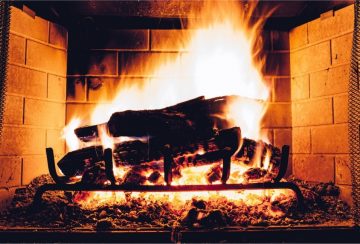Preparing your Fireplace for Winter - Oakford Firewood and Mulch

Preparing your Fireplace for Winter
- May 21, 2019
- Posted By admin
Though it might not feel like it yet, autumn is now here and winter is well on its way. The time has arrived to prepare wood burning fireplaces and stoves for the coming season. Fireplaces contribute to a large percentage of home fires; with some preparation, the risks can be reduced significantly.
Every fireplace, wood-burning stove, and other wood burning device located inside of the home needs to be inspected and cleaned prior to its first usage of the cold season.
1/ Check chimneys for rodents, possums, birds, and nests. If not already in place, have a cap or screen installed so that critters will be kept out in the future.
2/ Inspect the flue on chimneys and wood stoves to ensure it opens and closes smoothly and easily. Keep flues closed when the burner or chimney is not in use (only after fires are totally extinguished). Open flues let in cold draughts. Make sure to open flues before lighting a new fire in the fireplace.
3/ Have a professional chimney sweep come to your home at the beginning of the season, to clean and remove built up soot and creosote from the previous season. (Creosote is an unburned fuel and can catch fire if sparks flying upward ignite it). Have them also check chimneys for structural damage, cracks, missing mortar, faulty lining, and loose bricks.
4/ Clean the fireplace thoroughly. Remove ash, soot, and old wood. Use a wire brush to scrub the walls with warm water and dish soap. Clean fireplace tools as well.
5/ Clean wood stove exhaust pipes before the first use, and then periodically throughout the season.
6/ Make sure you have plenty of premium Perth firewood for the season. Estimate your winter usage plus at least ten to twenty percent. You don’t want to find you’ve run out of firewood on the coldest day! Any leftover firewood will keep for the following season, or can be useful for summer barbecues.
7/ When you choose premium Perth firewood, select a dense hardwood that has been split and stored dry.
8/ When using your fireplace or wood stove, be mindful not to overload it. Small fires are known to generate less smoke and less hazardous creosote build up. Additionally, a fire which is too large or burns too hot can cause a chimney to crack – representing not only expensive repairs, but also a higher house fire risk.
9/ Remove flammable items from around and in front of the wood stove or fireplace. This includes rugs, magazines, books, furniture, newspapers, etc.
10/ Always start a fire with kindling rather than any flammable liquid. Logs should be placed at the rear of the fireplace on the metal grate.
11/ Always use a mesh metal screen or glass fireplace doors to prevent sparks flying into the room. This will also keep small children and pets out of the fireplace.
12/ Check all smoke detectors in the home and replace batteries.
With some mindful preparation now, you will be able to relax and enjoy the benefits of having your own fireplace or wood stove throughout the coming winter. There is nothing quite like an authentic wood fire on a cold night!
